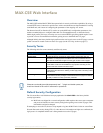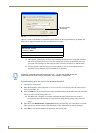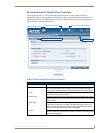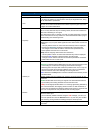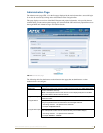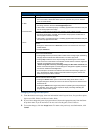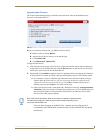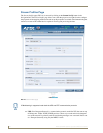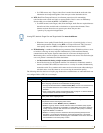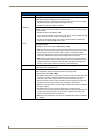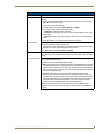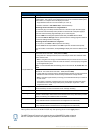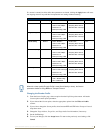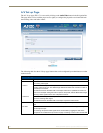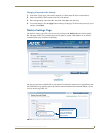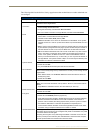
MAX-CSE Web Interface
27
MAX-CSE/MAX-CSD10 Operation/Reference Guide
In a UDP stream, only a Target (video) Port is needed since both the audio and video
information are transported together to the same port on the destination device.
RTP (Real-Time Transport Protocol) is an Internet protocol used for transmitting
real-time data such as audio and video as separate entities. Data is sent as an Elementary
Stream which can use both the MPEG-2 and MPEG-4 codecs.
In an RTP stream, both a Target (video) Port and Target Audio Port are required because
the audio and video are delivered to a destination as separate data elements. These
elements are then directed to two separate ports where they are then
"synced-up" by target device/application.
When the a lower quality Encoder Profile is used (such as Standard Quality or lower),
the Stream parameters default to using RTP as a Transport Protocol. This is because
lower quality video uses MPEG-4 compression which must be sent via RTP.
IP Multicasting is a method of sending out large amounts of data. IP Multicast allows a server
to broadcast a message to many recipients simultaneously. Unlike traditional Internet
communication, that requires separate connections for each source-destination pair, IP
Multicasting allows several recipients to share data from the same source. This means that just
one set of packets is transmitted to all the destinations.
An ideal method of sharing a single stream to several destinations.
One of the best uses for this method would be if an educator (or institution) wanted to
stream (via either UDP or RTP) its lecture series to a variety of students simultaneously
around the world. Every student could connect and receive the stream without having to
wait their turn to view the content or see a severe drop in transmission quality.
The following table lists the Stream Profiles page features that an administrator or other authorized user
can configure. Refer to FIG. 16 as an example.
If using RTP, both the Target Port and Target Audio Port must be different.
Stream Profiles Page Features
Feature Description
Encoder Profile: A drop-down list of preset encoding profile names which the user can choose from
when assigning a particular set of audio/video encoding settings.
• Although the default selection is Home Theater (Max), the user can choose from up
to 6 pre-created entries and one Custom entry which makes every field user-
definable.
• Refer to the Encoder Profiles and Parameters table on page 31 to view the details of
these pre-defined audio/video encoding parameters.
Video: This section allows the user/administrator to define the encoding parameters for the
video portion of the outgoing stream.
Codec A drop-down list of codecs from which the user can choose the type of MPEG video
compression used for the outgoing video stream.
• Available MPEG codecs: MPEG-2 (default) or MPEG-4
• MPEG-2 is typically used to encode audio and video for broadcast quality signals.
The MPEG-2 is enhanced by using MPEG-1's audio (MP2) component to allow the
coding of audio programs with more than two channels. Video quality is noticeably
higher with MPEG-2 vs. MPEG-4.
• MPEG-4 is currently used as a standard for the web (streaming media) and CD
distribution, conversational (videophone), and broadcast television. The biggest
difference between these two encoding types is that MPEG-4 uses about 1/3 to 1/2
less bandwidth for the same quality of video.



